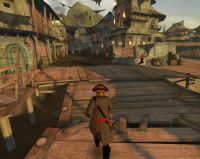Building communities through residency
I’m pretty bad at keeping up with The Escapist‘s weekly issues. Right now my inbox has a backlog of thirty unread articles from as early as January, and getting round to digesting them always seems to be more effort than it turns out to be. The Escapist’s team almost always deliver, as any of my fellow readers will tell you, and particularly pertinently with John Tynes’ 28th of February Contrarian column which I will be talking about today.
Despite my having no interest in role-playing whatsoever, the article articulates one of the largest problems I see both the persistent and indeed instanced online games of today suffering: the challenge of building a strong, flexible and navigable community. It is no longer enough to throw a forum together and expect people to make do. So significant is community strength that the success of platforms like the Xbox 360 is becoming defined by it, and with Wikification becoming an ever more relevant practice community spirit, or the lack of it, is going to affect more than the hard-core player base, and not just titles offering persistent worlds.
How can Steam help overcome these issues?
Drawing out the internal

It is hard to convey the scale and depth of EVE’s universe in a single image. Here, the star map is seen edge-on.
Community features are one of the goals of Steam 3.0, in fact you could argue the main goal. Steam gives MMO developers (and other developers too) an enormous advantage with its residency in the system tray, one that Tynes identifies early on, if in a generic context.
The power this instant accessibility provides cannot be underestimated. EVE Online players: how would you like to keep track of, make and alter even, your orders from the desktop? View the star map and plan trade routes over Friends whenever your partner across the globe needs to, without having to load the whole game? Access EveMail? Receive chat messages? There are countless functions today enclosed in MMO clients across the market that are begging to be drawn out, and it takes a general-purpose resident application like the Steam client to both provide them and keep them readily available.
EVE is only one example of course, albeit one rich in potential, and if you play another major MMO you should have no difficulty compiling a similar list of your own, nor I’ll bet grinning at the thought of it becoming reality.
Bringing in the external
But moving in-game functions to the desktop isn’t half the story. The real potential of residency is to be found in integrating what happens on the wider web, that is, what people want to do within the game but cannot — something that Tynes sensibly generalises as blogging. Why, though? Isn’t the web good enough? Yes — the key word being enough. Interfacing with HTML might be flexible and portable, but when compared to applications it introduces many limitations. You can have all the AJAX you want, but while you might break even if you are good, you are never going to beat a true desktop application. Plug-ins defeat the objective: why have a plug-in wrapped in a web browser when you can have an identical tool without that extra layer? A desktop app can be 3D accelerated, completely unreliant on remote servers, and most importantly of all interlinked client-side with far more precision and depth to its parent game. What’s more, through the use of XML applied to client-side templates, replacing a web page with a desktop tool can massively reduce bandwidth and loading times too.
Building blogging into an authentication system like Steam also removes the need to revalidate your identity and reduces the number of hoops through which a user must jump to use the features. This latter point in particular is a bigger benefit than you may think. How many people contribute to the World of Warcraft community site? How many people visit it? How many people play the game? I don’t know all the numbers myself, but I can guarantee that they increase exponentially in the order I listed them. Integrating the site’s features into the WOW client would eliminate both the hoop of registering and the hoop of finding the site in the first place, increasing contributions and usage.
A text box with a ‘post’ button followed by another one called ‘comment’ might make the core components of a blog, but it is a poor use of residency. Links to the gameworld, the interlinking of internal and external in this new middle ground, are where the benefits become clear. Clickable waypoints that take your guildmates to that loot drop or party guests to the tavern is Tynes’ first example. Links to objects in the game world, perhaps ones that you crafted and want to sell, are another possibility. As before, your own wishlist will probably be better than mine.
Aiding Wikification
Stepping out of the MMO sphere for a moment, we might extend our remit to custom content. Garrysmod.org is the in-development community site for the hyper-creative Garry’s Mod community to share their work. But like many content portals it is cut off from the mod itself (I should point out that Gmod is merely a recognisable example, and in fact far better in this regard than most). To contribute to it in any way you must register an account, and to use anything downloaded from it you must know where to manually install the content and manage any conflicts with other content yourself. These are all barriers to entry, and there isn’t any sensible way of resolving the issues without client-side code of some sort. In his article User Content: Working with players to efficiently create profitable games, Danc provides some figures to illustrate the issue:
One of the titles that I have personal interest in is Age of Wonder. They have a robust mod and mapmaking archive online, a strong community site and great tools. Recently, they polled the online users and asked if they used mods. 64% had never tried to install a mod. Only 20% successfully used mods with any frequency. This sample is heavily biased towards mod usage since we know that 80 to 90% of single player users do not participate in online community sites. This patterns exists a number of other games.
Of course, these figures are for a very different type of game than a Wikified or persistent one and they shouldn’t be applied to any of the examples in this piece. Nonetheless, they give some insight into the numbers involved.
Moving a community site’s functionality into the desktop forms a different sort of link, one of the shared knowledge that is crucial to anything player-driven. To some extent the link is already in place, with Lua not needing any form of download and construction projects appearing fully-formed whenever a server is joined. But these links are thin and one-way. I can’t use that SWEP myself unless I can get the source code to it, and that means downloading it from a website. Similarly, I can’t save the contraption my mate just made (and in a multiplayer game neither for that matter can he) for later use without one of the more advanced community-built Lua scripts going around. And if I don’t connect to a server running something, I’m unlikely to ever know that it exists. An integrated solution would allow me to download anything I saw, assuming the server operator allowed it, and at the other level widen the breadth of sharing by removing the limitation of needing to be on a server where content is in use to discover and acquire it. Happily, it may be that such a system is already on the way, depending on the flexibility of Valve’s upcoming P2P distribution system.
In short, creating the content for a Wikified game is lots of fun, but distributing and collecting it through the traditional means is above Joe Gamer’s abilities.
Steam’s role
Any application can be resident. What sets Steam above current and future competition is VGUI. A VGUI application automatically functions from both the desktop and any VGUI-enabled game. Any desktop app made for a Steam game can potentially be accessed from any point in any game that supports the standard (which is a part of the Steam SDK), Friends and the server browser the two current examples of the technology in action. What’s more, the two versions can be open at the same time and seamlessly exchange input and data; you can try this with Friends and windowed game.
A second important role Steam plays is that of a centralised host, a straightforward advantage compared to tens of fragmented and probably unjustifiable ‘launchers’ for standalone games that nobody in their right mind would keep running at the same time. This centralisation also allows for the possibility of data exchange between apps, and again reduces the number of separate authentications needed across the board.
Conclusion
In conclusion, we can draw three main points:
- The merging and interlinking of in-game and web-based functionality is one of the most important processes supported by resident applications such as Steam.
- A centralised, accessible and useful set of community tools with minimal barriers to entry encourages community participation and increases enjoyment.
- Wikified games are severely handicapped without a broad, user friendly and accessible distribution system for player-made content.
As it happens, all we have seen of Steam’s community-building so far has been Friends, and if you wanted to make that argument Valve’s weekly updates. And not unreasonably, as there are no MMOs nor commercial Wiki games on Steam yet. Yet. What of Pirates of the Burning Sea? I wouldn’t worry: John Tynes, the Contrarian himself, is lead writer and designer for the whole project.
Shortly after this article went live Sony gave their GDC2006 keynote, focusing on their ‘PlayStation Network Platform’ and toting it in part as an ‘integrated content system’ much like the model set out here.
Resources
- Future Imperfect (Jim Rossignol/The Escapist)
- Growing Out of the Stone Age (John Tynes/The Escapist)
- User Content: Working with players to efficiently create profitable games (Danc/Lost Garden)





15 Responses to this post:
Comments
Lunchtimemama Says:
The better example for user-created-content sharing is Second Life. And I agree.
Trigger- Says:
It really is exciting to think of the possibilities. I agree and support the fact that 80-90% of players don’t jive with surfing gamesites. Bringing a games unique comunity content to a torrent type application is some very groundbreaking thinking, and i for one am excited to see what bringing this content to the rest of the 80-90% of the will do for the scenes as a whole.
Andy Simpson Says:
I have to agree on many of those points. Community can be an incredibly ethereal thing and making it easy for people to actually work together on a common objective is pretty tough. Look at pub games of CS or DoD, the amount of teamwork is utterly minimal.
I think the most successful game for getting people to work together is Natural Selection. For the marines, unity is absolutely vital, and for the aliens… the hive sight promotes a glorious working together through anarchy. Everyone kinda does their own thing, but it all comes together in victory. Hopefully.
Anyways, the big thing in this at the end of the day seems to be to be integration, which I would say was the holy grail of technology anyway. If only my house alarm integrated with my house’s lights, then I could just have lights which only switched on when the motion sensor picked me up. Anyways, the problem is that integration of this kind is very, very, very, hard!
Even with say, the public Friends API offered by Steam from now on, I’d bet you the vast majority of non-Source games are just not going to bother with it. Developers are just not going to put the effort in to integrate Friends with their games. Red Orchestra doesn’t even use the ‘proper’ Steam FS, let alone Friends, or the Server browser. The most they use is the Steam authentication service.
Valve has to take this thing they’ve built and try and make it less Valve-centric, and that’s the honest truth. The server browser has no method of properly supporting other query methods, for instance. I have this horrible feeling that for RO:O to use the Steam server browser, it would have to respond to queries identically to how Source and Half-Life servers do, because there’s no simple means I can see of just plugging in a module that can handle that kind of query.
VGUI is not a selling point. No third party developers with their own game engines are going to use VGUI. They have their own GUI systems, and they’re not gonna be compatible, despite the advantages of being able to render in and out of game the same way. They’re gonna want something they can extensively modify themselves.
I guess I’m a pessimist, but it takes forever for people to start working together properly, and even so, people will always rather reinvent the wheel on stuff like this than use another company’s tech if they can. And if it’s something as simple as logging in to community features, you’re just never gonna see someone saying, “hey, we’re using Steam, so let’s build a Steam plugin so we can use the single login id” they’re just gonna go ahead and roll out a forum or something.
The only company people don’t really seem to be ashamed of relying on when it comes to APIs is Microsoft, and heck, how many apps don’t use standard Windows UI components anyway, just as a simple example. There are a lot of good APIs out there that never get used by anyone.
Tom Edwards Says:
RO is actually using Friends (and VAC for that matter), it just isn’t visible yet. RDKF works with the server browser too. I do agree with you on VGUI though: I’m pretty sure that the Steam SDK comes with the source code to it, but even considering that I can believe your argument. 😉
Andy Simpson Says:
It is? Wow, that’s good to hear. Yeh, I was hoping you wouldn’t notice I didn’t mention RDKF, ah well. The point still stands though, the code to enable RDKF server queries was built directly into the main Steam binaries, which means Valve had to do it. Pretty flakey, if you ask me. Means Valve probably have a policy (or just haven’t thought about it, which is possibly worse) about letting third parties write plugins for the Steam client itself.
Tom Edwards Says:
Not at all, RDKF uses its own master server. Look in
config/masterservers.vdf.Andrew Timson Says:
Sin, when it comes to Steam, will also be using the Steam server browser; I doubt it uses VGUI, though, given that all the UI elements were built years ago. 😉
Andy Simpson Says:
RDKF may use its own master server, but that doesn’t say anything about what protocol it’s using, and either way, the support for it is still built right into the Steam client by Valve themselves, which I would still say was the major issue. For this kinda residence to work, the platform has to be a lot more open, whereas it is very closed at the moment. So closed that I’m more or less having to guess what it is capable of. As is everyone…
7 Trackbacks/Pings
Gameroom Blog
Community content integrated in Portal - The Steam Review
The Steam Platform - The Steam Review
Steam Community Beta impressions - The Steam Review
Future Steam technology wrap-up - The Steam Review
Integration - Steam Users Forums
Evil Avatar - Eve Online Gets Steamed